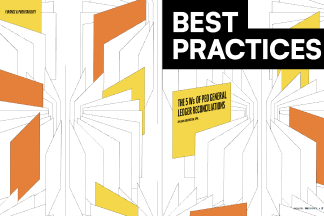The feedback loop, by definition, is a process where the outputs of a system are circled back and used as inputs. Yikes! I just had a flashback to 10th grade science. That definition just sounds so mechanical. Well, technically it can be… but if you think about what that definition is actually saying, it is relevant to everything we do, every day. And when we apply the principle of the feedback loop in the proper way, with purpose, it can be a powerful tool with limitless applications in this complex business we are in.
Every moment we are either giving or getting feedback. Think about all the interactions with our colleagues, vendors, clients, worksite employees…ourselves! But are we doing that in a manner that improves us? Expands our business? Enhances our vendor relationships? Contributes to the success of those around us? If we operate without purpose, which is easy to do, the answer is no.
We are living in an “endemic” of information overload and constant busy. With flexible schedules and remote employees, how often are you having meaningful interactions with your colleagues? With rising costs and the need to improve bottom lines, how often are we building our relationships with vendors? In an effort to continuously grow, do our current clients fall to the wayside?
So how do we improve and overcome this challenge? Being purposeful with feedback.
As professionals in the people business, we are typically strong communicators. We know the basics of the feedback loop without even knowing that we are executing them. We listen, ask, analyze and act. It seems simple. So why is it so hard? We don’t break it down or understand what to do with it all. Let’s bucket where we want or need feedback, how to get it and what do to with it.
CLIENTS, WSES, AND INTERNAL EMPLOYEES
Do you know if your service exceeds client and worksite employees’ expectations or just hits the mark? How is your internal culture? Do you have surveys in place to measure these items? How do you know what your clients, worksite employees and colleagues really want or prefer? If your answer to these is no, or I’m not sure, understand that this client feedback (whether good or bad) is crucial to collect, analyze and act upon to help your business grow.
As businessowners we all want to hear kudos from happy customers and be the best employer. We don’t want to hear the bad stuff, BUT this “bad stuff” is where the opportunities lie to improve a process, policy, interaction or service offering. It’s where your organization can innovate and grow. It may be easier to not ask for feedback, but wouldn’t you rather hear the truth?
If you have not yet directly asked for feedback, there is no better time to start than now. Engage your team, your clients and their teams. Be present either physically in person or virtually. Have meaningful conversations and let them know you care. If you are using surveys, keep in mind to draft them with the understanding that the questions must be realistically actionable. If you are currently surveying your clients, are you analyzing the results and acting upon them? If not, what message does that send? Finally, thank them for sharing their experience and detail your plans for improvement.
VENDORS
As an executive or leader, do you have your finger on the pulse of these relationships? Enough to provide feedback? In many cases, we just rely on our vendors to be mind readers. We expect them to do the impossible just because “we pay them”. Unfortunately, it doesn’t work this way, and, in many cases, we only hear about the problems that exist from our team. Just like we want our clients to be “partners”, our vendors want the same.
How do you know what is going on with your vendors before there are problems? Try having a vendor discussion in your leadership meetings. Understand what is going well and what areas may need improvement. If you aren’t having a regular cadence meeting with your critical vendors, now is a good time to start. The potential for improvement within your service offering and the relationship is immense. Something as simple as this can dramatically improve your processes, products and ultimately those improvements get passed on to your clients… strengthening your partnerships.
OURSELVES
This one is tough. Sometimes, as leaders, we just don’t have a system for any feedback, let alone realistic feedback. We move swiftly and often make quick decisions with limited information. The feedback we receive can be jarring because it’s usually provided via success or failure…whether in our actions or the performance of the business. Why is that? It doesn’t need to be if we took our own advice of listen, ask, analyze and act.
While this is a massive topic, we only have 1000 words in this article. I could recommend you read industry veteran Brent Tilson’s Go Slow to Grow Fast or just make some simple, thoughtful adjustments.
Surround yourself with capable leaders. Be approachable and let them know you are open to feedback as warranted. Have regular, dedicated cadence meetings where there are opportunities to give and receive that feedback. When you get feedback, listen. Have a willingness to act and/or make a change if necessary.
I’ll end with a story that highlights the wide impact of the feedback loop. Three years ago, my business partner (and sister) gave some feedback to our critical partner, PrismHR. She indicated the need for more training. The executive she spoke with was receptive and excited to hear her ideas. This year at Prism Live, this executive called Jenn out in the main session and credited her for providing that feedback and prompting them to take action. This executive listened, analyzed and most importantly, acted. Jenn approached and provided feedback in a purposeful manner based on our company’s outputs. To think about how many companies, employees, clients and worksite employees have benefited from the inputs of that single piece of output. That is powerful.
It takes thought, effort and may require slowing down a bit, but when you trust the feedback loop and you provide the output… you will most always be pleasantly surprised in the resulting inputs.
-
SHARE
- Copy to clipboard




